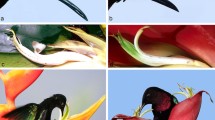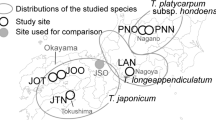Summary
In the Monteverde (Costa Rica) cloud forest, the distylous treelet Palicourea lasiorrachis (Rubiaceae) is pollinated by the hummingbird Lampornis calolaema. Only intermorph pollinations result in seed set. In a series of 47 experimental trials, we compared pollen carryover from thrum (short-styled) flowers to pin (long-styled) flowers with carryover from pin to thrum flowers. In one experiment, captive L. calolaema first probed 2 flowers of one style morph, then a series of 20 flowers of the other style morph. In the second experiment, 2 flowers of a frequent associate of P. lasiorrachis, the treelet Cephaelis elata (Rubiaceae), intervened between donor and recipient Palicourea flowers. We assessed intermorph pollinations by counting pollen tubes in recipients' styles. Without Cephaelis intervening, thrum donors transferred many fewer total grains to pins than did pin donors to thrums. However, thrum grains were dispersed more evenly among recipient pin flowers than were pin grains among thrum recipients. As a result, the potential for paternal reproductive success was at least as great for thrum flowers as for pins. With insertion of Cephaelis flowers into the foraging sequence, the magnitude of differences between carryover patterns declined.
Similar content being viewed by others
References
Barrett SCH, Glover DE (1985) On the Darwinian hypothesis of the adaptive significance of tristyly. Evolution 39:766–774
Bawa KS, Beach JH (1983) Self-incompatibility systems in the Rubiaceae of a tropical lowland wet forest. Amer J Bot 70:1281–1288
Beach JH, Bawa KS (1980) Role of pollinators in the evolution of dioecy from distyly. Evolution 34:467–474
Bir Bahadur (1970) Heterostyly in Rubiaceae: a review. J Osmania Univ (Science), Golden Jubilee Vol: 207–238
Brewbaker, JL, Majumder SK (1961) Cultural studies of the pollen population effect and the self-incompatibility inhibition. Am J Bot 48:457–464
Campbell DR, Waser NM (1987) The evolution of plant mating systems: multilocus simulations of pollen dispersal. Amer Nat 129:593–609
Cruden RW (1976) Intraspecific variation in pollen-ovule ratios and nectar secretion—preliminary evidence of ecotypic adaptation. Ann Missouri Bot Gdn 63:277–289
Cruden RW (1977) Pollen-ovule ratios: a conservative indicator of breeding systems in flowering plants. Evolution 31:32–46
Darwin C (1888) The different forms of flowers on plants of the same species, 2nd ed. John Murray, London
Feinsinger P, Murray KG, Kinsman S, Busby WH (1986) Floral neighborhood and pollination success in four hummingbirdpollinated cloud forest plant species. Ecology 67:449–464
Feinsinger P, Beach JH, Linhart YB, Busby WH, Murray KG (1987) Disturbance, pollinator predictability, and pollination success among Costa Rican cloud forest plants. Ecology (in press)
Ganders FR (1974) Disassortative pollination in the distylous plant Jepsonia heterandra. Canad J Bot 52:2401–2406
Ganders FR (1975) Fecundity in distylous and self-incompatible homostylous plants of Mitchella repens (Rubiaceae). Evolution 29:186–188
Ganders FR (1976) Pollen flow in distylous populations of Amsinckia (Boraginaceae). Canad J Bot 54:2530–2535
Ganders FR (1979) The biology of heterostyly. NZ J Bot 17:607–635
Geber MA (1985) The relationship of plant size to self-pollination in Mertensia ciliata. Ecology 66: 762–772
Hicks DJ, Wyatt R, Meagher TR (1985) Reproductive biology of distylous partridgeberry, Mitchella repens. Amer J Bot 72:1503–1514
Lertzman KP, Gass CL (1983) Alternative models of pollen transfer. In: Jones CE, Little RJ (eds) Handbook of experimental pollination biology, Van Nostrand Reinhold, NY, pp 474–489
Lloyd DG (1979) Parental strategies of angiosperms. NZ J Bot 17:595–606
Lloyd DG, Bawa KS (1983) Modification of the gender of seed plants in varying conditions. Evol Biol 17:255–338
Martin FW (1959) Staining and observing pollen tubes in the style by means of fluorescence. Stain Technol 34:125–128
Mulcahy DL, Curtis PS, Snow AA (1983) Pollen competition in a natural population. In: Jones CE, Little RJ (eds) Handbook of experimental pollination biology, Van Nostrand Reinhold, NY, pp 330–337
Nicholls MS (1985a) Pollen flow, population composition, and the adaptive significance of distyly in Linum tenuifolium L. (Linaceae). Biol J Linn Soc (London) 25:235–242
Nicholls MS (1985b) Population composition, gender specialization, and the adaptive significance of distyly in Linum perenne (Linaceae). New Phytol 102:209–217
Ornduff R (1975a) Heterostyly and pollen flow in Hypericum aegypticum (Guttiferae). Bot J Linn Soc (London) 71:51–57
Ornduff R (1975b) Pollen flow in Lythrum junceum, a tristylous species. New Phytol 75:161–166
Ornduff R (1980) Heterostyly, population composition, and pollen flow in Hedyotis caerulea. Amer J Bot 67:95–103
Phillipp M, Schou O (1981) An unusual heteromorphic incompatibility system: distyly, self-incompatibility, pollen load and fecundity in Anchusa officinalis (Boraginaceae). New Phytol 89:693–703
Piper JG, Charlesworth B, Charlesworth D (1986) Breeding system evolution in Primula vulgaris and the role of reproductive assurance. Heredity 56:207–217
Price MV, Waser NM (1982) Experimental studies of pollen carryover: hummingbirds and Ipomopsis aggregata. Oecologia (Berlin) 54:353–358
Price SD, Barrett SCH (1984) The function and adaptive significance of tristyly in Pontederia cordata L. (Pontederiaceae). Biol J Linn Soc (London) 21:315–329
Rama Swamy N, Bir Bahadur (1984) Pollen flow in dimorphic Turnera subulata (Turneraceae). New Phytol 98:205–209
Schou O (1983) The distyly in Primula elatior (L.) Hill (Primulaceae), with a study of flowering phenology and pollen flow. Bot J Linn Soc (London) 86:261–274
Shore JS, Barrett SCH (1984) The effect of pollination intensity and incomptible pollen on seed set in Turnera ulmifolia (Turneraceae). Canad J Bot 62:1298–1303
Sobrevila C, Ramirez N, Xena de Enrech N (1983) Reproductive biology of Palicourea fendleri and P. petiolaris (Rubiaceae), heterostylous shrubs of a tropical cloud forest. Biotropica 15:161–169
Stephenson AG, Bertin RI (1983) Male competition, female choice, and sexual selection in plants. In: Real LA (ed) Pollination biology, Academic Press, NY, pp 110–149
Thomson JD (1986) Pollen transport and deposition by bumble bees in Erythronium: influences of floral nectar and bee grooming. J Ecol 74:329–342
Thomson JD, Plowright RC (1980) Pollen carryover, nectar rewards, and pollinator behavior with special reference to Diervilla lonicera. Oecologia (Berlin) 46:68–74
Thomson JD, Price MV, Waser NM, Stratton DA (1986) Comparative studies of pollen and fluorescent dye transport by bumble bees visiting Erythronium grandiflorum. Oecologia (Berlin) 69:561–566
Vuilleumier BS (1967) The origin and evolutionary development of heterostyly in the angiosperms. Evolution 21:210–226
Waser NM (1978) Interspecific pollen transfer and competition between co-occurring plant species. Oecologia (Berlin) 36:223–236
Waser NM, Price MV (1984) Experimental studies of pollen carryover: effects of floral variablility in Ipomopsis aggregata. Oecologia (Berlin) 62:262–268
Weller SG (1980) Pollen flow and fecundity in populations of Lithospermum caroliniense. Amer J Bot 67:1334–1341
Wyatt R (1983) Pollinator-plant interactions and the evolution of breeding systems. In: Real LA (ed) Pollination biology, Academic Press, New York, pp 51–95
Author information
Authors and Affiliations
Rights and permissions
About this article
Cite this article
Feinsinger, P., Busby, W.H. Pollen carryover: experimental comparisons between morphs of Palicourea lasiorrachis (Rubiaceae), a distylous, bird-pollinated, tropical treelet. Oecologia 73, 231–235 (1987). https://doi.org/10.1007/BF00377512
Received:
Issue Date:
DOI: https://doi.org/10.1007/BF00377512




